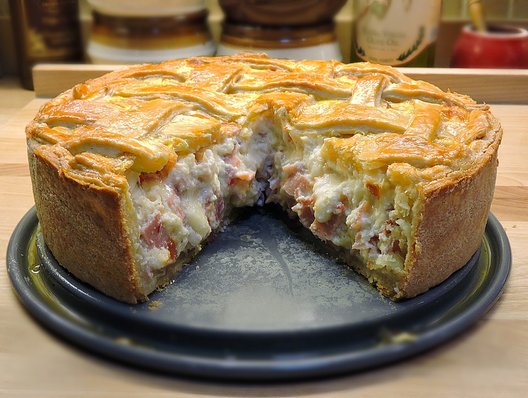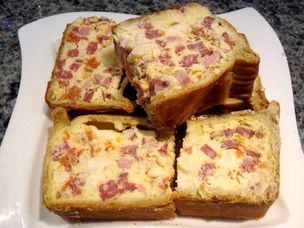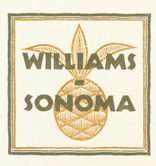|
When I was a young boy we would drive down to Hoboken (Click to read about our visit to a Hoboken Festival) to visit my Uncle Sal and Aunt Antionette in their red brick row house. The part I loved best was their lower floor... I suppose you could call it a basement, but it was really like a finished apartment, even though there were large, silver-painted heating pipes running along the ceiling, with the aging Nonna Finzi sitting quietly in the lower front parlor as the loud chaos of our Italian families cooked, played and teased each other. When it was warm out, the men would play and gamble and argue in the bocce court behind their vegetable garden. But most of all, I remember the kitchen down there... white subway tile running all the way up to meet the ceiling... and the big pots... and those great smells. It seems that just about every time I visited, there was a huge pot of Sunday Gravy on the stove top simmering and letting its rich smells escape through the place and into my nostrils. There seemed to be an endless supply of meatballs (polpette), sausages and brasciole. Then at Easter time there was a real treat: Pizzagaina. In our family, that's what we called it. PizzaGAINA, pronounced PEETS-a-GAYN-a. But depending on what part of Italy your family comes from, and the dialect spoken, you might hear it called any of the following: Pizzachiena, Pizza Chena, or even Pizza Rustica. A rough translation in all cases is "full Pie" with the latter being "rustic pie". Pizza Cena would mean "dinner pie". There is also another version called Pizza Ripiena that is thinner and more of a double stuffed crust pizza, and definitely not as thick as the Pizzagaina "full" pies. Never thought about it before, but maybe they are called "full" because that's how they'll make you feel. It’s usually made before Easter on Good Friday and eaten on Easter Sunday as a celebratory meat pie to break the Lenten fast. After having given up all red meats during Lent, this dish is really going off the wagon because it contains lots of different meats and cheeses. An Easter feast might also have meat in other courses, too. You can imagine in times past how a spring lamb or pig were slaughtered or even a cinghiale (wild boar) was hunted and butchered in preparation for the Easter festa--a big deal after a lean winter and Lent. Usually, a hour or two before they put out the pasta, sausages, brasciole and meatballs, my Aunt Anne would put out a tray of mixed antipasti along with the Pizzagaina for slicing. While I loved picking on a few olives, some chunks of provolone and salami, the real prize was getting a nice wedge of pizzagaina. Often it was still warm with its thick, eggy, meaty filling of salty ham, salami, chunks of hard boiled eggs and other things I couldn't identify as a kid (more than likely mortadella or capicola). There are two ways to make this Easter pie--one using thin, layered slices of cold cut meats, with the other using diced pieces of meat and sausage. The base of the filling is made with egg and cheese, something similar to a French quiche (but to my taste, far less greasy). Pretty much every family will have it's own version. My Dad would call this type of recipe ba-BOOK-kia (sp?), a Molfetese dialect word he used to mean "all mixed up together". (I never did discover what word this was--if anyone knows, let me know). While the ingredients might be similar, everyone makes it differently, and the recipe might change from region to region, perhaps a frugal habit of using up what meats were left over by the time the long winter reached Easter. Some make it looking very much like a proper meat pie in a pie pan, while most use a high sided spring form pan. Still others might make a large one in a lasagna pan, with far too many eggs (in my opinion), and cutting squares to feed a large family gathering. On Easter Sunday this year, Lucas and I set out to make our own version of this classic holiday pie... Let us know how yours turned out! Babbo Finzi's Pizzagaina For the Dough 1 pound flour (to ensure a good crust, it's best to weigh the flour) 2 eggs 1/2 teaspoon salt 2 sticks cold butter (1/2 lb), cut into small pieces 1/4 cup whole or skim milk, plus a little more if needed at the end 1 beaten egg with a pinch of salt to brush the crust For the Filling 32 ounces ricotta cheese (well drained, preferably the night before) 1 dash nutmeg 25 cracks black pepper 2 large eggs 1 cup sharp provolone, 1/2" dice 1 cup Fontina, 1/2" dice 1 cup smoked mozzarella, 1/2" dice 1/2 cup Parmigiano-Reggiano or caciocavallo, grated 1/4 pound Boars Head Piccolo Prosciutto or Speck, sliced 1/8" thick 1/4 pound Boars Head Pickle Pepper or capicola, sliced 1/8" thick 1/4 pound Boars Head Crushed Peppermill Turkey, sliced 1/8" thick (NOTE: You can substitute 3/4 pounds of 3-4 of your favorite meats for the above... chicken, pork, ham, boar, sweet or spicy sausage broken up, etc.) A wide array of methods are use to make Pizzagaina Making the Dough for the Crust In either a stand mixer with a dough hook, or a food processor with a blade, add all the flour and salt and mix a bit before adding the small pieces of butter. If using a stand mixer, you can mix on medium--if using a food processor, pulse until the mixture starts coming together, but don't over process or your crust won't be flaky. Drizzle in the 1/4 cup milk and the 2 eggs (You can beat them before adding it you wish). This should make a dough ball form as you continue to mix/pulse. If the ball doesn't quite form, drizzle in a little bit more milk, but stop when a ball forms, then turn it out onto a work surface lightly dusted with flour. With your hands (but without kneading), press your dough into a large ball at first, then flatten it into a thick disk and wrap in plastic wrap and set aside to rest at room temperature. Do not over mix or knead your dough or it will be dense and loose its flakiness. Making the Filling
Putting Together the Pizzagaina
You can get 8 or 9 decent sized slices out of this pie. Serve as an robust antipasto or have a slice with a salad on the side for a lunch or light supper. You can also serve a slice with a dollop of marinara on the side. It's also great for an Easter breakfast or brunch. There you have it, our Pizzagaina recipe. I hope you like it. As you can see, I made mine so the cheese has a softer, creamier texture. I think it has a better mouth-feel than some of the gelatinous or dried out versions I have eaten. I'd love to hear what you think. Boun appetito e Bouna Pasqua! (Click HERE to see a similar recipe) --Jerry Finzi You can also follow Grand Voyage Italy on: Google+ StumbleUpon Tumblr Copyright 2016, Jerry Finzi - All Rights Reserved
|
Archives
May 2024
Categories
All
|













